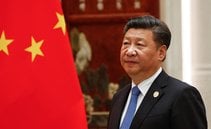How would World War III start? In this article, we show 2 possible scenarios of how a direct conflict between the United States and China could start.

What would World War III look like? As global tensions continue to rise between nuclear superpowers, with proxy wars between “the West and the Rest” in Ukraine and Palestine, this question becomes crucial. The United States, currently the world’s largest superpower, is increasingly challenged by its main rival: China.
Although seemingly in the background of the current wars, China is the main worry and strategic focus of the United States. Any war between these two nuclear powers would become the bloodiest conflict in history, and humanity must do anything possible to avoid it.
But, alas, both China and the United States are preparing for such a conflict. Only for defense purposes of course, but this “arms race” looks increasingly similar to the one preceding both World Wars.
So let’s look at the worst-case scenario. What would a direct war between the United States and China look like?
Where would World War III be fought?
Before showcasing two possible scenarios for world war, the current geopolitical situation must be analyzed.
In all likelihood, a direct conflict between the US and China would take place over Taiwan. The island, formally known as the Republic of China, is a close US-ally and a “rebel province” according to Beijing.
Mainland China assumed a worryingly aggressive posture against Taiwan, often threatening outright invasion to return the “rebels” under the “rightful” authority of the Chinese Communist Party.
On the other hand, US President Joe Biden often pledged allegiance to the Taiwanese cause, saying they would intervene in case of direct Chinese aggression.
This article analyses only two scenarios of direct conflict. It does not take into account the more likely intermediate steps China could take, like for example a naval blockade of Taiwan or a "simpler" invasion of Kinmen, a small island under Taiwanese authority but just 10km off China’s costs.
Scenario 1: the US protects Taiwan
Although President Biden promised the protection of Taiwan in case of Chinese aggression, promises can often be broken.
In this scenario, Beijing’s government would start an invasion of Taiwan without involving the United States directly. This means that Washington would have a very difficult decision to make: should they intervene in the protection of Taiwan and therefore start World War III?
If so, China would almost certainly claim that the Taiwanese crisis is an internal Chinese matter, therefore making the United States look like the aggressor. However, this could be easily countered by the United States, who would be coming to the protection of a close ally and would not have started the war first.
Furthermore, in this scenario, China would have to face the complete might of the United States Armed Forces. The US has two chains of military bases stretching from Singapore to South Korea, armed with aircraft carriers, nuclear submarines, battleships, and thousands of military personnel.
Such a military presence ensures that the United States could come to the defense of Taiwan in a matter of hours, ensuring a long, difficult, and likely ultimately unsuccessful war for China.
Scenario 2: XXI century Pearl Harbor
The American bases in the Pacific are well within striking distance from mainland China. Beijing possesses the capability of hitting these military facilities and rendering them harmless, at least temporarily.
In this scenario, China’s invasion of Taiwan would be preceded by a swift and surprise attack on American military bases. Although this would make the initial invasion of Taiwan easier, it would ensure a strong and brutal American response, as it would be considered a direct act of war.
In this case, Beijing would have a difficult decision to make: should they risk starting World War III to make the initial invasion of Taiwan significantly easier?
Again, American protection of Taiwan is not a guarantee. In World War II, the Japanese Empire worried so much about American intervention (although it was hardly certain they would get involved) that they struck first at the American fleet in Pearl Harbor.
This ensured Japanese dominance over the Pacific Ocean for the following months. However, by the time American industry caught up with the losses, the United States completely turned the tide around.
The only difference with today, of course, is that the Japanese Empire did not possess any nuclear weapon.







